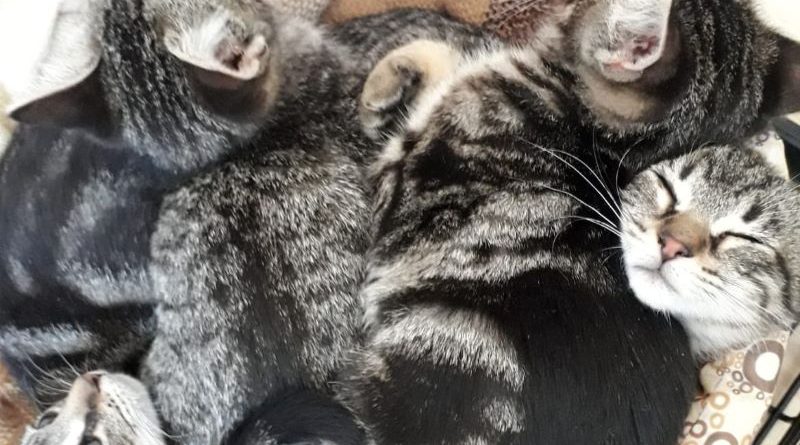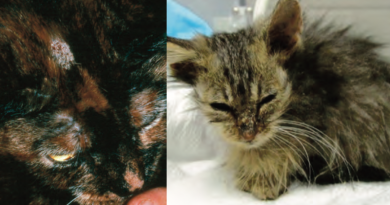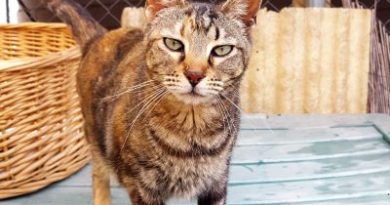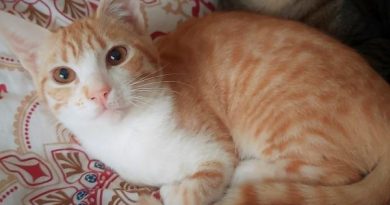Feline infectious peritonitis (FIP)
Feline infectious peritonitis (FIP) is a viral disease of cats that occurs throughout the world and is almost invariably a fatal disease.
Causes
Feline infectious peritonitis is caused by infection with a virus known as feline coronavirus. Coronaviruses are a common group of viruses that often infect the upper respiratory tract or gastrointestinal tract in different animals. Different species of coronavirus are adapted to cause disease in different animals. In humans, coronaviruses are one of the frequent causes of the common cold.
It is important to note that the coronaviruses affecting cats are different from the coronavirus which causes COVID-19 in people. In very technical terms, coronaviruses that affect cats (called feline coronaviruses or FCoV) are alpha-coronaviruses and the current SARS-Cov-2 coronavirus which causes COVID-19 in people is a beta-coronavirus. These are different diseases which occur in different species caused by different types of coronavirus. The FIP-causing feline coronavirus cannot affect people and, as far as we know, the COVID-19 causing coronavirus does not cause infection in cats.
In this article, we are referring to feline coronaviruses (FoCV) which just affect cats.
Infection with coronavirus is actually very common in cats, but most of the time it does not cause any problems, other than perhaps mild self-limiting diarrhoea. Uncommonly, the virus mutates (changes) to a strain of coronavirus which has the potential to cause disease. This mutated strain is the cause of FIP.
In an affected cat, the virus spreads throughout the body and can cause a wide range of different signs (including peritonitis with the accumulation of fluid in the abdomen, but in other cats, fluid may accumulate in the chest cavity; in others, the virus may cause inflammation affecting the brain, eyes, liver, kidneys or elsewhere).
How do cats get infected with coronavirus?
Coronavirus infection is extremely widespread in cats, especially where large numbers of cats are kept together. It is estimated that 25–40% of household pet cats have been infected with FCoV, but the infection rate increases to 80 – 100 per cent for cats kept in multi-cat households or colonies.
The virus mainly infects the intestinal tract, where it replicates. FCoV is shed in the faeces and may survive in the environment for a short while (several days or a few weeks), but is readily destroyed by common disinfectants. Infection is caused when a cat ingests the virus (e.g., through licking). The relationship between the virus and the cat is complex – some cats may remain persistently infected with FCoV and shed virus in their faeces the whole time; others may be infected, develop a strong immunity and be protected from future infections; and others may be infected and manage to eliminate the virus, but then get recurrent infections.
In most cases, infection with FCoV will cause mild signs of enteritis (mild, self-limiting diarrhoea), or sometimes no signs at all. Diarrhoea is more likely to be seen in young cats, but because it is mild and self-limiting a specific diagnosis of FCoV infection is almost never made.
How does FCoV cause FIP?
Infections with FCoV are usually limited to the intestinal tract, with very limited viral replication elsewhere. Strains of FCoV causing these infections are referred to as feline enteric coronavirus (or FECV). During infection, and while the virus replicates in the intestine, it undergoes spontaneous mutations. This leads to the development of different strains of the virus, and occasionally a strain may develop that has dramatically altered disease-causing potential – this viral strain is referred to as feline infectious peritonitis virus (FIPV). FIPV strains of FCoV differ from FECV in that they no longer replicate well in the intestine, but rather preferentially infect macrophages – one of the important cells of the immune system. The virus spreads throughout the body, and if replication is not contained by a good immune response, a cat will develop clinical signs of FIP.
In most cases, it appears that an FIP-producing strain of FCoV probably arises within a cat already infected with FCoV. In many (or even most) cases of FIP, the FIP-producing strains of the virus are not shed in the faeces of a cat with FIP.
When an FIP-producing strain of FCoV emerges, whether a cat will develop FIP or will remain healthy depends on the quality of its immune response. A strong immune response (especially the type of immunity termed ‘cell mediated immunity’) may enable the cat to control the infection and prevent signs developing.
What are the clinical signs of FIP?
FIP can cause a very wide range of clinical signs, and unfortunately none of these are unique for FIP – a diagnosis cannot therefore be based on clinical signs alone.
Early signs of FIP are usually very vague with a fluctuating fever, lethargy and inappetence being common. After a period of several days or weeks (or sometimes even many months) other signs usually develop. Two main forms of the disease are recognised known as ‘wet’ or ‘effusive’ disease, and ‘dry’ or ‘non-effusive’ disease. Many cats may in fact have a mix of these two types:
‘Wet’ or effusive FIP
Cat with feline infectious peritonitis showing a distended abdomen due to fluid accumulation. Purebred cats seem to be affected more commonly by the disease.
In this form of disease there is accumulation of fluid within the abdominal cavity (resulting in abdominal distension) and/or the chest cavity (resulting in breathing difficulties). The fluid accumulates because infection with FIPV causes damage to and inflammation of blood vessels (called ‘vasculitis’) which results in fluid leaking from the blood into the abdomen or chest. Cases that develop fluid accumulation in the abdomen are responsible for the original name of this disease, ‘peritonitis’ referring to the inflammation that occurs in the lining of the abdominal cavity.
In effusive FIP, the fluid that accumulates typically has a very high protein content, and is often a clear-yellowish colour. However, other diseases (including some liver diseases and neoplasia) can also cause a similar fluid accumulation.
‘Dry’ or non-effusive FIP
With non-effusive disease, infection with FIPV predominantly causes chronic (long-standing) inflammatory lesions to develop around blood vessels in many different organs and sites in the body. The type of changes present is usually what is known as ‘pyogranulomatous’ inflammation.
This inflammation affects the eyes in around 30% of cases and the brain in around 30% of cases, but can also affect almost any tissues in the body including the liver, kidneys, lungs and skin. Thus, a wide range of signs may be observed including neurological disease (e.g., a wobbly and unsteady gait), bleeding in the eyes and other vague signs of disease that may occur with lesions in the liver or other internal organs.
In most cases of FIP, once clinical signs have started, they tend to get progressively worse over time, and in most cases (though not all) the time course for disease is rapid, with cats deteriorating to the point that euthanasia is usually required within a matter of days or weeks. It is thought that non-effusive cases of FIP are where the cat has developed a partially effective immune response that helps to limit viral replication – this may prevent development of effusions, but is not sufficient to stop disease development.
In a number of cats, signs may develop that are a combination of both effusive and non-effusive disease.
What cats are most often affected with FIP?
Although FIP can occur in cats of any age, it is most often seen in young cats. Around 80% of cases diagnosed are in cats less than 2 years old, and many cases are seen in kittens around 4-12 months old. FIP is also more common in cats kept in groups or colonies (especially breeding households) as this is an environment where FCoV infections are spread easily. A crowded environment may also contribute to stress, which can be a factor in disease development as it compromises the cat’s immune response. There is evidence that genetics can also play a role in susceptibility to disease, although this is complex.
How can FIP be diagnosed?
FIP is a very difficult disease to deal with because there are no clinical signs that are specific for the diagnosis of FIP, and no simple blood test to confirm a diagnosis. FIP may be considered more likely when:
- Cats are showing clinical signs compatible with FIP
- Cats are in a higher risk category (e.g., younger cats, colony cats, etc.)
- Typical changes are seen on routine blood tests – these may include
- Lymphopenia (low numbers of lymphocytes, a type of white blood cell)
- Neutrophilia (increased numbers of neutrophils, a type of white blood cell)
- Anaemia
- Elevated globulin concentrations (one of the major groups of proteins in the blood)
- Elevated liver enzymes (eg, ALT, ALP)
- Elevated bilirubin (and jaundice or yellowing of the gums and eyes)
None of these blood changes are specific for FIP, occurring with other diseases too, but if multiple changes are seen in combination with appropriate signs, a diagnosis of FIP becomes more likely. Many of these abnormalities may also not be present in the early stages of the disease, but may become evident as the disease progresses. Thus some tests that give normal results may have to be repeated later.
If an effusion is present in the abdomen or chest cavity, obtaining a sample of the fluid and analysing the cell and protein content can be extremely helpful. With FIP the fluid invariably has a high protein content (greater than 35 g/l) and at least 50% of the proteins are globulins. Because this test is very helpful, and because few other diseases cause this type of fluid accumulation, when FIP is suspected a vet will often take X-rays or do an ultrasound examination to see if fluid is present so that a sample can be collected for analysis.
Other tests that can also sometimes be helpful include:
- Further analysis of proteins in the blood (e.g., looking at globulin sub-types or measuring the protein acid-1-alpha glycoprotein [AGP])
- Evaluation of a cerebrospinal fluid sample (the fluid that surround the brain and spinal cord) in cases where there are neurological signs
Looking for the presence of antibodies against the virus in a blood sample (coronavirus serology) is of very limited value – antibodies against FCoV develop irrespective of the type of virus infecting a cat and the antibody test cannot differentiate between different strains of the virus. A very large number of perfectly healthy cats are therefore positive on this test.
Confirming a diagnosis of FIP
The best test to confirm a diagnosis of FIP is to collect a biopsy (usually done through a surgical operation) from affected tissues. Typical FIP-type inflammation is usually seen, which is highly suggestive, but the diagnosis can be confirmed using a technique called ‘immunohistochemistry’ which will demonstrate the presence of the virus itself within the damaged tissues.
With FIP, unfortunately, a cat may be too sick for surgery to be performed, and so in many cases a definitive diagnosis may only made on post-mortem examination (using immunohistochemistry, as above).
The virus itself can also be detected by the use of PCR (polymerase chain reaction, a molecular technique to show the presence of the virus). This can be useful – for example if fluid is present in the chest or abdomen which has typical characteristics of FIP (see above), and if the fluid is also PCR positive for coronavirus, this is highly suggestive that FIP is the underlying cause. However, because PCR cannot distinguish different types of coronavirus (FIP-producing strains from enteritis-producing strains), this test is not definitive.
Treatment for FIP
FIP remains a challenging disease to treat and in many cases incurable and fatal. In most cases supportive care (fluid therapy, anti-inflammatory drugs) only relieve signs for a short time. Drugs such as interferon and polyprenyl immunostimulant have been trialled with mixed results. However, recent research by Professor Niels Pedersen of University of California, Davis, has shown that some newer anti-viral drugs such as GS-5734, used in humans against some emerging viruses, may be effective. This is a very exciting development in FIP research on a condition previously with a very bleak outlook. However, it must be emphasised that more research is needed, and commercially available products will take some time to test for safety and licence as veterinary drugs. At this time obtaining such products via the black market is not encouraged, as the safety of such drugs is unknown. For more information on Professor Pedersen’s research please visit https://icatcare.org/exciting-new-research-into-the-treatment-of-fip/.
Prevention of FIP
A commercial vaccine is available in some countries to help protect against FIP. However, this vaccine (while showing some efficacy) can only be given to kittens over 16 weeks of age. The major indication for using such a vaccine would be in breeding households, especially with a history of FIP, but by the time a kitten can be vaccinated (at 16 weeks) they would almost invariably have already been exposed to FCoV infection and so the vaccine probably has little or no value.
Reducing the risk in breeding households
FIP is least common in household pets. The risk can be minimised by obtaining cats from a source with relatively few cats and by keeping cats in small stable groups (less than five cats in a household).
In breeding catteries, eradicating coronavirus infections is extremely difficult, as the virus is so ubiquitous, and it is unsuitable in most situations to attempt this. A more practical approach is to use measures to reduce the risk of FIP occurring, but recognising that on occasions, this may happen even in the best run catteries. Good practice to minimise the risk of FIP would include:
- Avoid keeping large groups of cats and having multiple litters of kittens at any one time
- Keep cats in small isolated groups (ideally no more than four cats in each group – this reduces the risk of endemic FCoV infection)
- Have at least one litter box for every two cats, located in easy to clean and disinfect areas
- Keep litterboxes away from food and water bowls, and clean/disinfectant them regularly (at least daily)
- Avoid stress and maintain good hygiene and preventive healthcare for all cats
Wherever FIP occurs is a problem in a group of breeding cats:
- Consider preferentially breeding from older cats, as these will less likely be shedding FCoV
- Consider isolating queens just before they give birth and keeping the queen and kittens isolated from all other cats until the kittens are homed, as a means of reducing the risk of FCoV spread to kittens
- Stop breeding from any queens or tom cats that repeatedly produce litters of kittens that develop FIP as they may be passing on FCoV infection or may be passing on genetic susceptibility to disease
- Carefully review management and hygiene policies
- If faced with an outbreak of FIP, stop all breeding for several months
Reducing the risk in rescue and rehoming facilities
Good hygiene and avoiding overcrowding are essential strategies for minimising the risk of FIP. Cats should ideally be housed individually, or if this is not possible, they should be kept in small stable groups. Litter boxes and cleaning/disinfection should be managed as in breeding households.
References:
https://icatcare.org/advice/feline-infectious-peritonitis-fip/




